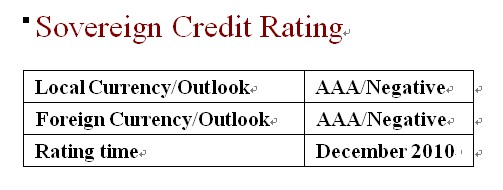
Rationale
Dagong assigns “AAA” to both the local and foreign
currency long term sovereign credit ratings of the Republic of Finland (hereinafter referred to as
“Finland”) based on a comprehensive
analysis of such factors as its lower government debt burden and fiscal deficit,
relatively sound financial system but declining economic strength.
After experiencing the serious impact of the financial
crisis to the Finnish economy, the government fiscal deficit emerged and the
debt burden increased by 20%. However, compared with other European countries,
Finland’s debt burden and fiscal
deficit ratio are still quite low. By the end of 2009, the general government’s
outstanding debt reached 43.8% of GDP, far below the average level of 79.2% in
the Euro Zone and the EU’s warning line of 60%. Meanwhile, the government debt
structure is relatively reasonable, which is dominated by local currency and
long term debt, thus the debt repayment burden in the short term is weak. Under
the premise of current economic downturn, the government continues its
expansionary fiscal policy in 2010, and the extent of fiscal expansion will be
far more than that of other European countries. It is estimated that the fiscal
deficit will break through the EU warning line of 3% and reach 4.5% of GDP by
the end of 2010. The government’s financing requirement and debt-to-GDP ratio
will increase to 15.7% and 50% respectively. With the economic recovery and the
implementation of fiscal consolidation, the government’s fiscal deficit ratio
and debt ratio will hopefully be controlled within the EU criteria of 3% and 60%
respectively.
The Finnish economic development model based on
innovative exports has driven its economic prosperity for a decade with current
account surplus, fiscal surplus and sound financial system, etc. However, the
vulnerability in the exports structure and economic development has been fully
exposed under the financial crisis. Furthermore, the existing problems as high
welfare policy, aging trends and shortcomings in the financial system have
constrained the government’s fiscal and monetary adjustment capacity.
Nevertheless, the long-standing cumulative wealth and the government’s strong
financial capacity can still ensure the government’s debt repayment.
Specifically, it is summarized as follows:
l
That the
government actively promotes the independent innovative system is conducive to
the development of high-tech industries and to driving economic growth. However,
the consequent problems such as heavy dependency on global markets and excess
capacity also restrict the future economic potential to some extent.
l
The
economic development is in a high level, but the economy was severely affected
by the financial crisis due to the vulnerabilities in export destination and
product structure. Owing to the insufficient domestic and external demand, the
economic growth prospects in the next 3-5 years look quite gloomy.
l
The
financial system has less exposure to the toxic assets; it is steady and
adaptable to the economic development. The risks such as narrow profit margin,
liquidity and credit risks in the financial system are under control compared
with other European countries.
l
The
government’s high welfare policy and aging trend exacerbate the difficulties for
the fiscal situation to return to surplus. However, the government’s large
amount of net assets and the strong financing capacity in the European financial
market guarantee its capacity of debt repayment.
Outlook
Subject to the economic development model and exports
structure, the Finnish economy suffered significantly in the financial crisis.
Due to the insufficient domestic and external demand, the economic recovery and
growth prospects in the next several years look gloomy, which is unfavorable for
the increase of government revenues and ultimate improvement of the existing
fiscal deficit situation. At the same time, the high welfare and tax policy and
aging trend restrict the government’s capacity to adjust fiscal revenues and
expenditure, while the heavy dependency on wholesale funding and increasing
default ratio in household and commercial loans in the economic downturn will
increase the government’s contingent debt burden. Although the government net
assets are quite large and the financing capacity in the European financial
market is strong, yet these advantages are gradually eroded by the current
sovereign debt crisis happened in the EU and Finland’s slow
pace of economic recovery. As a result, Dagong keeps the negative outlook for
the Finnish government’s local and foreign currency credit rating in the next
1-2 years.
|